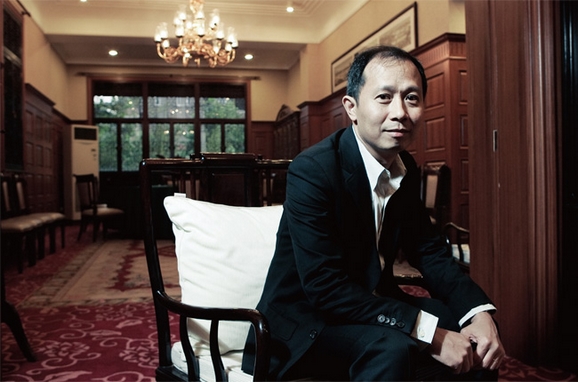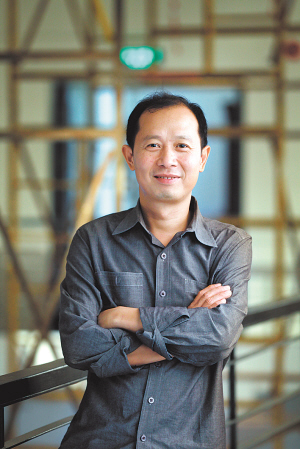Hou Hanru

Hou Hanru, Image Courtesy collection.chinaluxus.com
Hou Hanru (b. 1963, Guangzhou) is an internationally renowned art critic and curator. He received both his undergraduate and master's degrees from Central Academy of Fine Arts (CAFA) in Beijing, where he was trained in art history, with additional work in painting, performance, installation, and architectural research. In 1985, Hou assisted Maryn Varbanov in organizing the ‘Tapestry Art Exhibition’ in the National Art Museum of China (NAMOC). In 1988, alongside Yang Jiechang, Chen Tong and Tang Songwu and others, Hou staged the performance Language, Communication, Man in the Sun Yat-Sen Library in Guangzhou. That same year, he translated and published Concepts of Modern Art by Nikos Stangos, and the following year, he was one of the organizers of the ‘China/Avant-Garde Exhibition’ in Beijing.
After moving to Paris in 1990, Hou became an active curator and has organized and co-organized numerous important exhibitions such as "Cities on the Move" (Vienna, Bordeaux, New York Long Island, Denmark, London, Bangkok and Helsinki, 1997–2000); the second Johannesburg Biennale (1997); the Venice Biennale’s French Pavilion (1999); "Z.O.U. – Zone Of Urgency" at the Venice Biennale (2003); the Chinese Pavilion’s "Everyday Miracles" at the Venice Biennale (2007); the third Asia-Pacific Triennial of Contemporary Art (Australia, 1999); the third Shanghai Biennial (2000); the Gwangju Biennial (South Korea, 2002); the second Guangzhou Triennial (2005); the 10th Istanbul Biennial (2007); and the 10th Lyon Biennale (France, 2009).Coming to California via Paris, where he lived for sixteen years, Hou has brought a significant international voice on cultural difference to San Francisco. He is a contributor to international art journals including Frieze, Art in America, Art and Asia Pacific, and Yishu, etc, as well as catalogues and books of contemporary art and culture.
Maintaining his global profile, he is also a consultant for several cultural institutions including the Solomon Guggenheim Museum, Deutsche Bank Collection, Kadist Art Foundation, Times Museum (Guangzhou), and Rockbund Art Museum (Shanghai). He has served on the jury of many international awards including the Hugo Boss Prize (Guggenheim Museum), Chinese Contemporary Art Award (Beijing), Ars Fennica (Helsinki), Credit Suisse/Today Art Award, and (Today Art Museum, Beijing). He has taught and lectured in various artistic and educational institutions including Rijksakademie van Beeldende Kunsten (Amsterdam), HISk (Antwerp /Ghent), and numerous Universities and Museums across the world. He is the Director of Exhibitions and Public Programs and the Chair of the Exhibitions and Museum Studies program at the San Francisco Art Institute. He is currently curating the 5th Auckland Triennial( May - August 2013), New Zealand, and co-directing the World Biennial Forum (Gwangju).

Hou Hanru, Image Courtesy epaper.dfdaily.com
He once talked about his study at CAFA in an interview conducted by Asia Art Archive
When I studied in CAFA, the art history professors at the CAFA included Jin Weinuo, Xue Yongnian, Wang Long, Shao Dazhen, Li Chun, and Chang Youming etc. they were truly the best art historians in the country; they provided us with a deep knowledge of the field. Moreover, the foreign professors brought in by Jin Weinuo and the growing foreign student population on campus had a rather significant influence on me, since they brought with them a lot of new information and new approaches that personally impacted on me Additionally, the CAFA was located in the center of Beijing city then. While the school was rather small in size with no more than two hundred students, it was an enclave of people with extraordinary talents and eccentric personalities. Whenever people arrived in Beijing, the first thing they would do was to crash at their friend’s place at CAFA, hiding out in the dormitory for a few days. Many of the people from across the country were the elite in various fields and we would hang out with them. Among the art academies, CAFA was the most avant-garde and subversive. We also hung out with students from the painting department. There were students who moved up from the affiliated Secondary School to CAFA. From very early on, they were pretty rebellious since the city of Beijing provided them with access to many different things. Some of them were involved with Rock & Roll and they organized many underground activities. The Rock star Cui Jian held his earliest performance in the Academy. The film director Wang Xiaoshuai graduated from the Secondary School affiliated with CAFA. They would frequently hang out with us on campus. The first time I remember seeing Cui Jian was in the cafeteria when we were eating together. He was a trumpet player back then sporting a very interesting hair-cut like a bowl sitting upside down on his head. We played and grew up together in an environment full of underground people from all over the country, and this experience exerted a subtle influence on us.
Communism was still very much alive and thus we would receive an education for free. Not only that, the state also paid money to you to “go down to the countryside” for two or three months every year. Unlike painting students who went to the countryside to paint, we history students went to do archaeological fieldwork. Due to his expertise in Buddhist art, Jin Weinuo took us to Xumishan Grottoes and Dunhuang Grottoes. During our four years in college we conducted two large scale surveys on Xuminshan Grottoes and Guangyuan Grottoes. We were the earliest researchers to conduct archaeological fieldwork at these two sites. Our research findings were then published. We learned to build scaffolding and draw construction blueprints without the help of any computers or equipment. This experience taught me an important lesson about self-organization. I learned how to carry out an idea and put thought into action.
At that time we would read whatever we could get. We would concurrently read multiple books. Interestingly, as I go down memory lane I realize that I have always been partial to the alternative way. In short, I despise anything considered very fashionable. If there is something that seems like spittle hair to other people and receives no attention from them, I intuitively find it interesting. I tend to shy away from anything romantic and lean towards something more…, not profound, but peculiar. I think this tendency has something to do with how I conduct myself, especially around the issue of deconstructing nationalism. For example, as a form of resistance, when I read I never think in Mandarin Chinese, only Cantonese. The way I learned English was from when the professors spoke Chinese in class, I’d simultaneously translated the lecture into English. I would keep writing in English until they flowed nicely. Language is more than just a tool; it is a state of mind.
Pigeons on the Grass Alas: Interview with Hou Hanru published by the Exhibitions program of The Pew Center for Arts & Heritage on 12 March, 2013
(Posted by Peter Nesbett, for further information please visit www.pcah.us.blog )
Who and what most influence your curatorial practice?Bada Shanren, Ni Zhan, Jin Nong, Huaisu, Yan Zhenqing, Gu Yanwu, Huang Yong Ping, Mao Zedong, Paul Cézanne, Piet Mondrian, Russian Constructivism, Bauhaus, Cubism, Dada, Joseph Beuys, Yves Klein, Happening, Maryn Varbanov, Michel Foucault, Roland Barthes, Jacques Dérrida, Frantz Fanon, Edward Said, Homi K. Bhabha, Arjun Appadurai, Paul Feyerabend, Samuel Beckett, Bertolt Brecht, Guy Debord, Situationists, Rem Koolhaas, Constant, Merzbau by Kurt Schwitters, Cathédrale de Chatres, Notre Dame de Paris, la Basilique Ste-Madeleine de Vézelay, Lindesfarne Gospel, Metabolism, Archigram, Led Zeppelin, Ludwig Beethoven, Pink Floyd, David Bowie, Serge Gainsbourg, Canto Songs by Sam Hui and George Lam, etc., Pearl River Delta as a social laboratory for the last 2,000 years, the world of the 1980s, especially 1989 (with China Avant-Garde movement, Magicians de la terre, Tian'an Men Event, the fall of the Berlin Wall, the death of Ceausescu...) Pélé, Hakim Bey, Autonomia, Toni Negri, Frankfurt School, Ludwig Wittgenstein, The Name of the Rose, Trainspotting, Pulp Fiction, "informal economy"...and endless things related to utopia, chaos, and derision.
What does your daily practice consist of?Working, reading, meeting, cooking, eating, drinking, traveling, some exercise like swimming, running and a lot of wasting of time while being infinitely busy...and occasionally dreaming under both the sun and the moon.
What do you think are the most urgent issues in the field right now?Curating as a living process, a performative experience inspired by but distinguished from both real life and intellectual reflections. Exhibition as site of production of new social projects. Contemporary art and globalisation, migration, urban transformation, public space, politics, and alternative ways of existing, creating, and social construction...experimenting as permanent state of being. Resisting all kinds of established powers and orders. Self-organisation, urban guerrilla and direct democracy...and the invention of new "institutions" as networks of global insurrection against the dominant culture of fear consciously or unconsciously promoted by the current bureaucratic and corporative spectacles and their institutions.
What is your ideal working relationship with artists?As close as possible, emphasizing the interactive and collaborative process, and collective intelligence...opening to all forms of "artists"—professional or "amateur" alike.
Who do you curate for?A small part of the art world and a great part of the "normal world," hopefully.
Related reports:
1. Interview with Hou Hanru by Asia Art Archive
2. Pigeons on the Grass Alas: Hou Hanru by the Exhibitions program of The Pew Center for Arts & Heritage
























